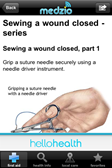MED3OOO announces that Family HealthCare Network (CA) plans to implement InteGreat EHR for 90 physicians across 11 community-based ambulatory care clinics.
Surescripts releases a report claiming that 17% of office-based prescribers are now using e-prescribing tools.This is up from 12% in 2008 and 6% in 2007. The company notes that in the first three months of 2009, active prescribers have jumped from 74,000 to 103,000. More pharmacies are also on board, with 76% of community pharmacies and six of the largest mail-order pharmacies now connected for prescription routing. Could this be a sign that we have reached the tipping point?
Eclipsys announces a new release of its PeakPractice PM/EMR aimed at ambulatory surgery centers.
Health Choice Network is implementing Sage Intergy CHC and EHR at 26 community health centers across the country.

Medzio releases a new, free mobile phone application for use on the iPhone. Features include basic first aid information, locations of the nearest medical facilities, and interactive health information. Inga downloaded the application to her iPhone and found it to be very intuitive and easy to navigate. The first aid covers everything from spider bites to more seriously emergencies, such as heart attacks. Inga especially liked the “Sewing a wound closed” series, complete with graphics and step-by-step instructions (sure to be a big hit at her next dinner party.) She also says the application accurately located the nearest emergency medical facilities, but was disappointed that the only area pharmacies listed were the national chains. Will the tool necessarily help doctors? Not really, but it might help their patients determine what constitutes an emergency.
Nuance Communications releases the results of a study showing how real-time speech recognition software can accelerate the transition to and adoption of EHRs. Nuance, which sells the Dragon Medical software, claims that 81% of surveyed physicians say Dragon improved the quality of their notes, 81% say it reduced transcription costs, and 69% say it made EHR use faster. If you are a clinician using Dragon with your EHR, let us know if you agree with the findings.
When it comes to electronic medical records, what does the public think? A new study finds that most Americans believe EMRs would improve quality of care, reduce medical errors, and facilitate the coordination of care. However, most fear that EMRs won’t save them or the country money, and, fear for the privacy of their records. When you think about it, aren’t these findings similar to what most doctors have been saying for years? In other words, don’t most providers believe in EMRs’ potential to improve care, but don’t believe it will save them any money, and, fear patient records could be compromised?
Medical Present Value releases a combined patient estimate calculator and eligibility and benefits verification tool for physician offices.The application provides practices with real-time eligibility verification, plus determines the patient’s out-of-pocket responsibility.
Pondering: if you are a company like MPV, selling a non-clinical that does not appear to benefit from the ARRA stimulus funds, are you currently finding providers less interested in your products? In other words, are buyers primarily focused on EMR solutions, and ignoring the business side for now? At HIMSS we heard several companies making a pitch along these lines: We has a new solution to help doctors increase revenues, just in time for them to spend that extra money on EMR. Is that the right pitch?

Ordinarily, the announcement of a new billing service would not be deemed very newsworthy. However, we like the name (Dr. America Billing) almost as much as the Inga-esque Avatar logo.
The American Medical Association signs a five-year contract with Compuware Covisint to provide a Web portal for its 240,000 members.The portal will provide physicians information on various products, services, and resources for improved practice efficiency, including the adoption of HIT and EHRs. E-prescribing company DrFirst says they are the first company to announce they’re working with the AMA on the project, which is expected to launch in early 2010.
Last year almost one in every 1,000 doctors received serious disciplinary actions by state medical boards. Alaska was the top-ranking state for disciplining physicians with 6.5 actions per 1,000 doctors. That compares to the most lenient state, Minnesota, which took action on fewer than one in a thousand.
Will this Minnesota doctor be disciplined? Or simply sued? A patient has surgery to remove his appendix and is sent home. Two days later he is re-admitted after the surgeon realizes he had mistakenly removed a piece of fat instead. By the time the second surgery is performed, the appendix burst, complications ensued, and the patient remained in the hospital for 11 days.

At an age when many physicians are contemplating retirement, 65-year old Dr. Bill Haggerson of North Carolina returns to military service to care for injured American soldiers. Haggerson, who spent 20 years in the Navy, was inspired to re-up with the military after his son was deployed to Iraq in 2002. Last September he closed his private practice and spent seven months in Iraq. He is now leaving for a one year stint in Afghanistan. Definitely our nomination for Hero of the Week.












The article about Pediatric Associates in CA has a nugget with a potentially outsized impact: the implication that VFC vaccines…